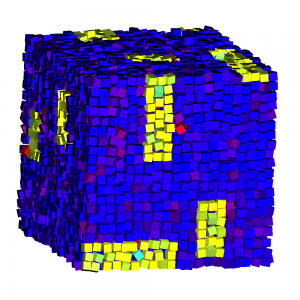Colloidal Self-Assembly via Computer Simulations
Dr. Laura Filion
We study the self-organization of colloidal particles using computer simulations. We focus on simple model systems where the interaction between the colloids is treated using coarse-grained potentials. Broadly, our research can be subdivided into two main categories: “passive” colloidal particles which self-assemble purely due to Brownian motion, and “active” colloidal particles which absorb energy from their environment in order to self-propel. Using a wide range of computational and theoretical techniques, we aim to predict and characterize the equilibrium and steady-state structures formed when these particles self-assemble. Moreover, we investigate the nucleation processes which govern the formation of these structures.
One example of our current work is the diffusion of defects in colloidal crystals. In particular, we are currently exploring defect dynamics in two highly mobile crystalline phases, namely the diffusion of vacancies in crystals of hard cubes (see Fig. 1), and the diffusion of interstitials in binary hard-sphere crystals. In both cases we use a combination of Monte Carlo simulations with event-driven molecular dynamics simulations in order to characterize the behavior of the defects, leading to a better understanding of the dynamics in crystals.

A crystal of colloidal cubes where some of the vacancies are highlighted in yellow. The vacancies are shared by a number of lattice sites along one of the lattice directions.
Key publications
- F. Smallenburg, L. Filion, M. Marechal, M. Dijkstra, Proceedings of the National Academy of Sciences, 109 (2012) 17886, “Vacancy-stabilized crystalline order in hard cubes“
- L. Filion, M. Hermes, R. Ni, E.C.M. Vermolen, A. Kuijk, C.G. Christova, J.C.P. Stiefelhagen, T. Vissers, A. van Blaaderen, and M. Dijkstra, Physical Review Letters, 107 (2011) 168302, “Self-assembly of a colloidal interstitial solid with tunable sublattice doping”
- L. Filion, M. Marechal, B. van Oorschot, D. Pelt, F. Smallenburg, and M. Dijkstra, Physical Review Letters, 103 (2009) 188302, “Efficient Method for Predicting Crystal Structures at Finite Temperature: Variable Box Shape Simulations“
